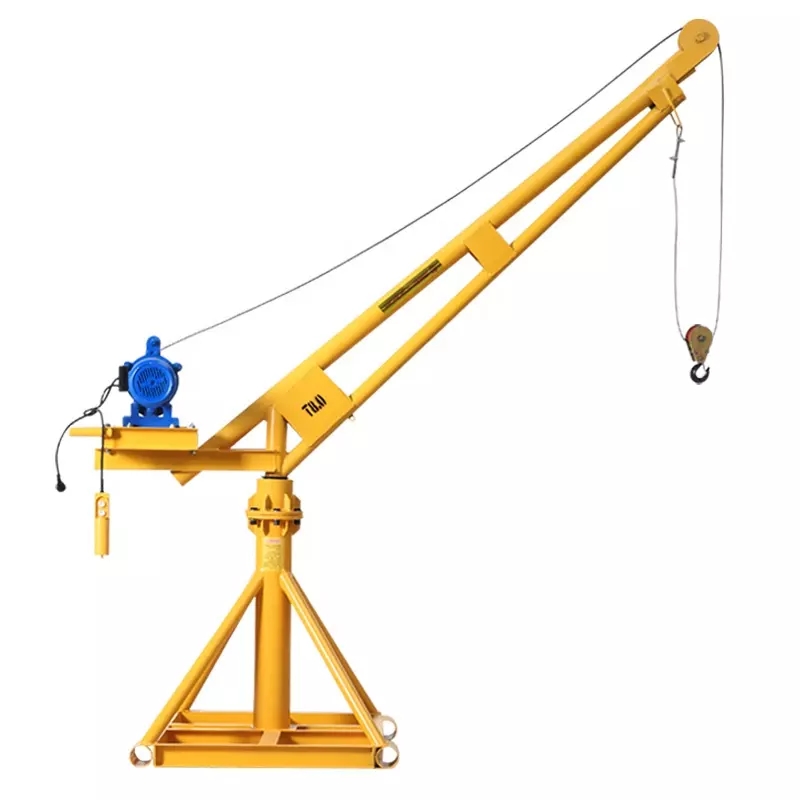Small portable cranes are designed to be versatile and adaptable to changes in site conditions or project requirements. Here’s how they typically adapt:
- Compact and Maneuverable: Small portable cranes are designed to be compact and lightweight, allowing them to navigate through tight spaces and maneuver easily around obstacles on construction sites. This flexibility enables them to adapt to changing site conditions or layout constraints without difficulty.
- Adjustable Boom Length: Many small portable cranes feature adjustable boom lengths that can be extended or retracted to accommodate different lifting heights or reach requirements. This flexibility allows operators to adjust the crane’s configuration on the fly to meet the needs of specific lifting tasks or project conditions.
- Variable Load Capacity: Small portable cranes often have variable load capacities, allowing them to lift a wide range of loads depending on the specific model and configuration. Operators can adjust the crane’s load capacity to match the weight of the load being lifted, ensuring safe and efficient operation in various lifting scenarios.
- Multiple Attachment Options: Small portable cranes may come with a variety of attachment options, such as hooks, slings, or specialized lifting attachments, to accommodate different types of loads or lifting requirements. These interchangeable attachments allow operators to customize the crane’s configuration to suit the needs of specific lifting tasks or project conditions.
- Adaptable Power Sources: Small portable cranes can be powered by various sources, including electric, hydraulic, or diesel engines, depending on the specific model and application requirements. This adaptability allows operators to choose the most suitable power source for the job based on factors such as site access, fuel availability, and environmental considerations.
- Easy Setup and Transport: Small portable cranes are designed for quick and easy setup, allowing them to be deployed rapidly in response to changing project requirements or site conditions. Many models feature foldable or telescopic booms, retractable outriggers, and other space-saving features that facilitate transportation and setup in confined or challenging environments.
- Remote Control Operation: Some small portable cranes are equipped with remote control systems that allow operators to control the crane from a safe distance. This remote control capability enhances safety and efficiency by providing operators with greater flexibility and visibility during lifting operations, especially in hazardous or hard-to-reach areas.
Overall, small portable cranes are highly adaptable and versatile lifting solutions that can be easily customized to meet the changing needs of construction sites or project requirements. Their compact size, adjustable features, multiple attachment options, adaptable power sources, easy setup, and remote control operation make them valuable tools for a wide range of lifting applications in diverse environments.
What are the financial incentives for using small portable crane in construction projects?
Using small portable cranes in construction projects can offer several financial incentives and benefits for contractors and project owners. Here are some of the key financial incentives:
- Reduced Labor Costs: Small portable cranes require fewer operators to operate compared to larger cranes, which typically require a dedicated crane operator and additional support personnel. By using a small portable crane, contractors can reduce labor costs associated with crane operation and maintenance, leading to overall cost savings on the project.
- Lower Equipment Costs: Small portable cranes are generally more affordable to purchase or rent compared to larger cranes, which can be costly to acquire and maintain. Contractors can save money on equipment costs by opting for a small portable crane that meets their lifting needs without the added expense of larger, more expensive equipment.
- Increased Efficiency: Small portable cranes are designed for quick setup and easy maneuverability, allowing contractors to complete lifting tasks more efficiently and with fewer delays. This increased efficiency can result in faster project completion times, reducing overall project costs and maximizing returns on investment.
- Versatility and Flexibility: Small portable cranes are versatile tools that can be used for a wide range of lifting applications, from lifting materials and equipment to placing structural components and performing maintenance tasks. Their compact size and maneuverability make them well-suited for use in confined spaces or challenging environments, providing contractors with greater flexibility in project planning and execution.
- Reduced Downtime: Small portable cranes are less susceptible to downtime compared to larger cranes, small portable crane lift which may require more extensive maintenance or repairs. By using a small portable crane, contractors can minimize downtime associated with equipment failures or breakdowns, ensuring that lifting tasks can be completed on schedule without costly delays.
- Lower Transportation Costs: Small portable cranes are typically easier and less expensive to transport to and from construction sites compared to larger cranes, which may require specialized transportation and permits. Contractors can save money on transportation costs by using a small portable crane that can be easily towed or transported using standard vehicles or trailers.
- Improved Safety: Small portable cranes are designed with safety features and mechanisms to prevent accidents and injuries during lifting operations. By prioritizing safety, contractors can reduce the risk of workplace accidents and associated costs, such as worker compensation claims, fines, and legal liabilities.
Overall, using small portable cranes in construction projects can provide significant financial incentives, including reduced labor and equipment costs, increased efficiency, versatility and flexibility, reduced downtime, lower transportation costs, and improved safety. These financial benefits make small portable cranes an attractive and cost-effective solution for lifting tasks in a variety of construction applications.

